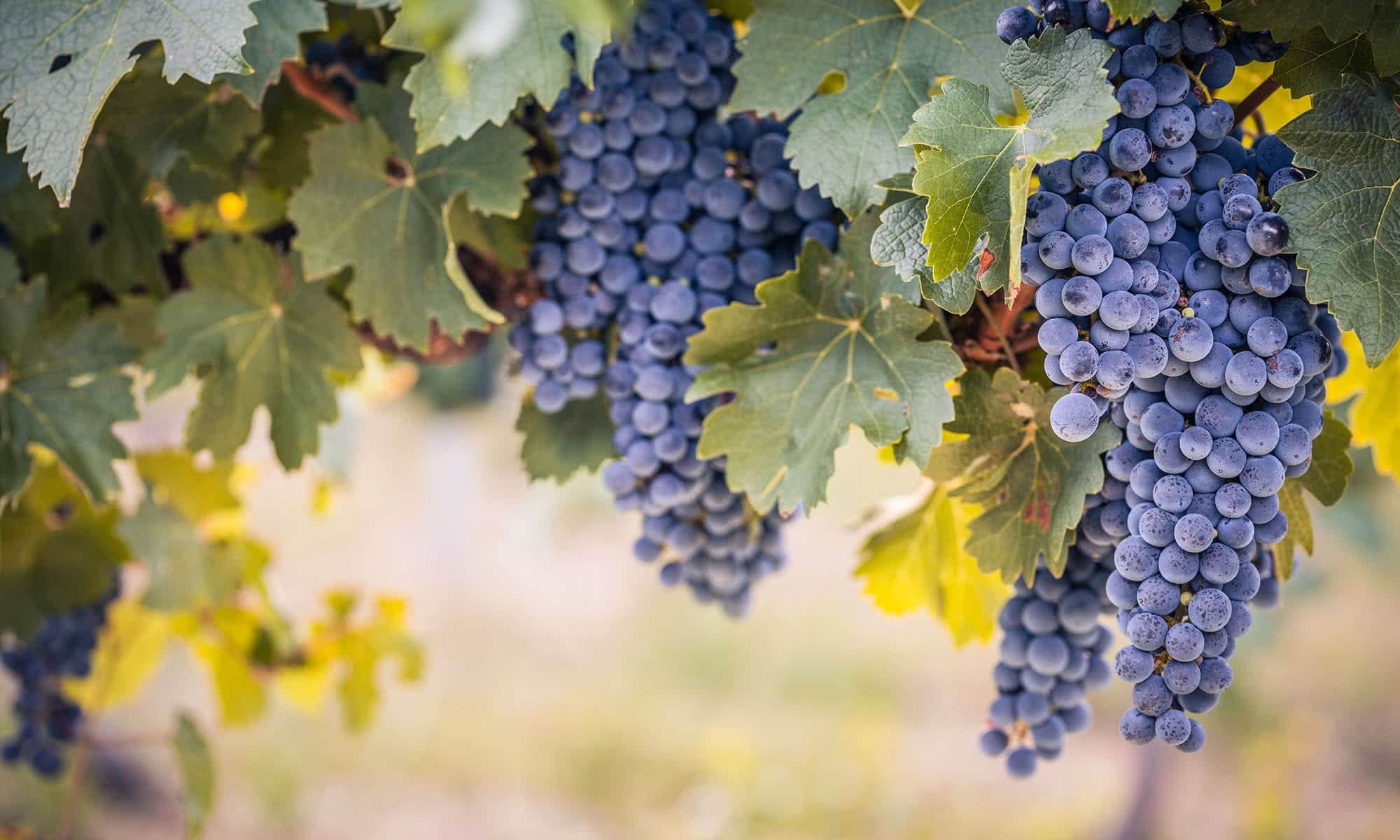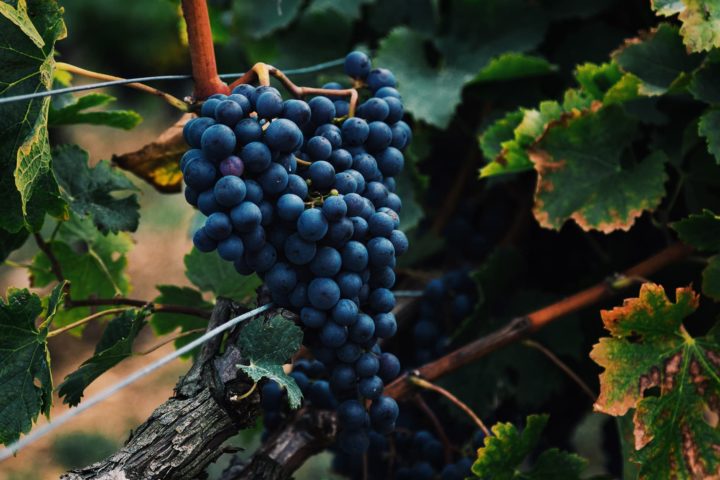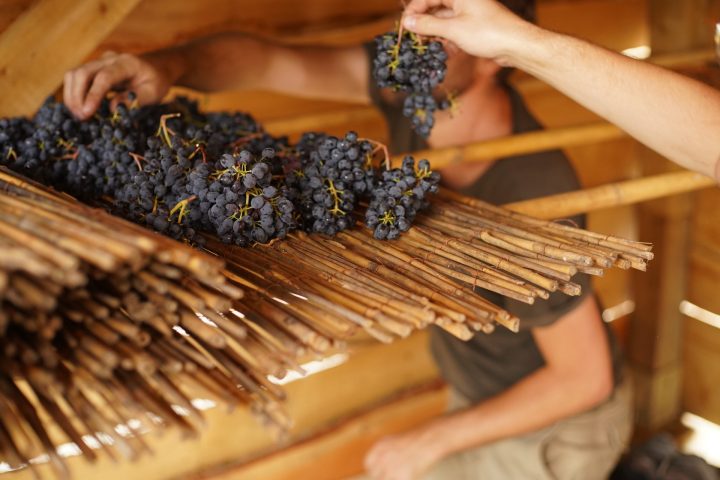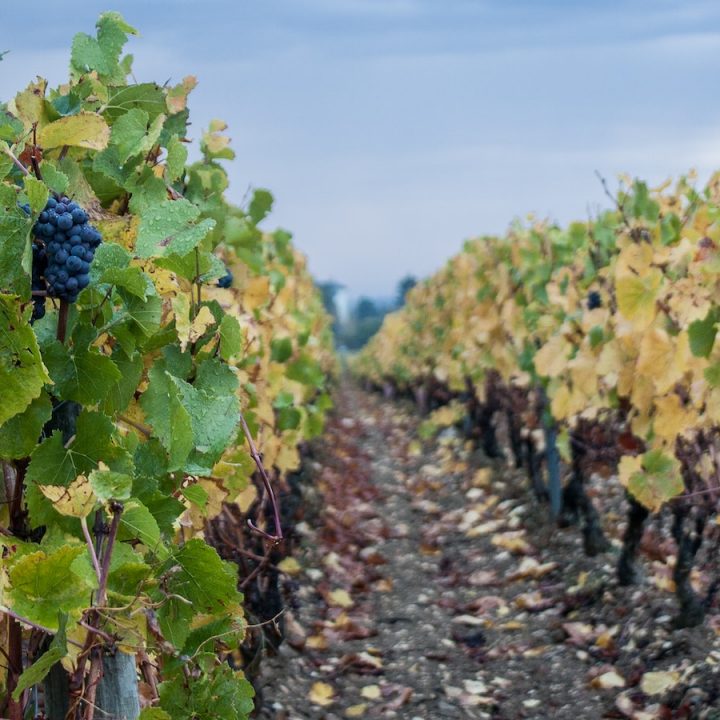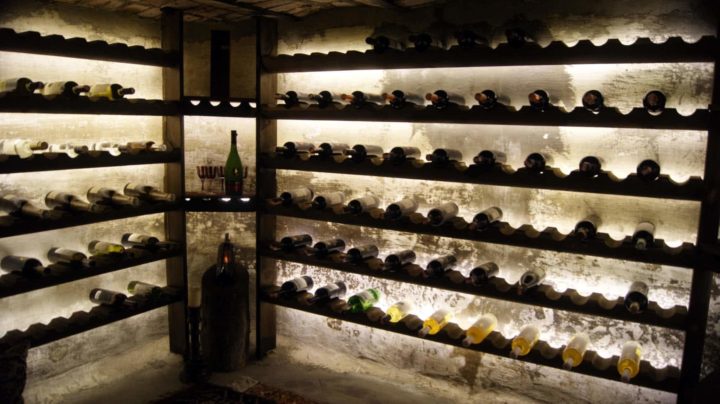Cabernet Sauvignon is the most widely grown red wine grape in the world and a natural cross between Cabernet Franc and the white grape variety Sauvignon Blanc. Cab, as it is also called by its fans, has its original home in Bordeaux, France, but thanks to its many qualities it can be found in almost every wine-producing country in the world. The qualitative spearhead for wines from Cabernet Sauvignon are the USA and Italy. His wines are highly appreciated for their high concentration and good shelf life.
The classic wine profile of Cabernet Sauvignon is a full-bodied wine with strong tannins and a pronounced acid structure. These characteristics are responsible for the great aging potential of its wines.
In this article you will learn everything interesting and worth knowing about the most popular of the red grape varieties and why it is so popular among wine connoisseurs.
The history of Cabernet Sauvignon
About the exact origin of Cabernet Sauvignon entwined for a long time many myths. For example, it is said to have been an ancient grape variety that may have been used by the Romans to make wine. This assumption still persisted in the 18th century. The culprit was the then common name for the grape variety “Bidure”.
It was believed that the name bidure was derived from the ancient variety Biturica, which was mentioned in records as early as the first century by Pliny the Elder.
The time when the name Cabernet Sauvignon became established is also not clear beyond doubt. However, records indicate that the grape was grown under this name in the Médoc region in the 18th century. The first wineries to specifically grow Cabernet Sauvignon grapes for wine production were Château de Mouton and Chateau d’Armailhan.
A research group at the UC Davis Department of Viticulture and Enology, led by Dr. Carole Meredith, was able to use DNA analysis to determine the true parentage of the vine in 1996. Through the analysis of its DNA, it was determined that the grape variety Cabernet Sauvignon was accidentally created in the seventeenth century from a cross between Cabernet Franc and Sauvignon Blanc. Prior to this finding, the relationship between the varieties was only suspected due to their similarities and the fact that Cabernet Sauvignon shares aromas with Cabernet franc and Sauvignon blanc, such as black currant, green bell pepper and graphite.
With the complete sequencing of the Cabernet Sauvignon grape genome by UC Davis researchers in 2016, the Cabernet Sauvignon grape is the first commercial grape variety to have its genome sequenced.
Cultivation and distribution of the grape variety – At home in France, at home in the world!
Cabernet has long outgrown its French homeland, and since the 1970s at the latest, it has found its perfect second home in the USA. However, the grape variety can now be found in almost every wine-producing country in the world. Thanks to the advancing climate change, Cabernet Sauvignon can now be found even in actually cool growing regions.
Due to climate change, the grape variety is now also enjoying growing popularity in Germany, as it can handle higher temperatures much better than Pinot Noir. With 219 hectares, its largest acreage is found in the rolling hills of the Palatinate region.
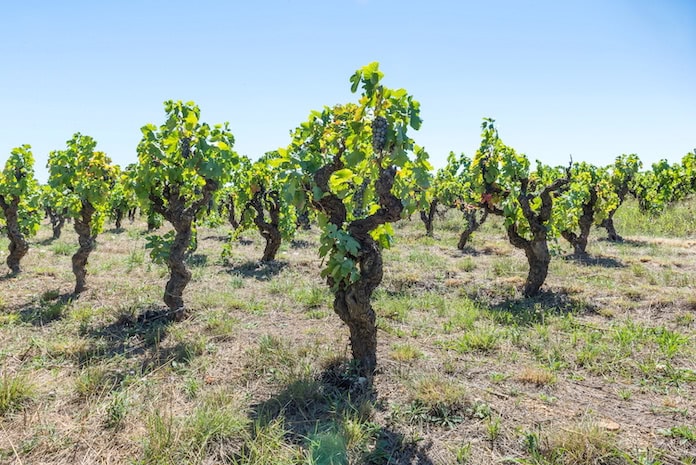
Vineyard properties
As a particularly late-sprouting variety, Cabernet Sauvignon rarely fears spring frost damage. Even though Cabernet is considered a fairly resistant grape variety, it is susceptible to some fungal diseases such as powdery mildew or black spot (excoriose).
Cabernet Sauvignon does not make special demands on its soils. However, the climate has much more influence on the choice of the right base. In cooler and rainy regions like Bordeaux, it needs a water-permeable soil structure that simultaneously stores and releases heat to the plants. Therefore, in hot and dry climates, the variety tends to stand on poor soils (e.g. clay, alluvium and limestone soils), which slows its growth and reduces the need for water.
Cabernet Sauvignon tends to produce high yields, which is why a strict reduction of yields in the vineyard is necessary to guarantee a high quality wine. Choosing the right rootstock can also contribute to successful yield reduction. Excessive yields result in less concentrated, flabby and comparatively tasteless wines.
As a late-ripening variety, wet and cold fall weather is a challenge in cool regions like Bordeaux. For this reason, the grapes are usually harvested earlier, before maximum ripeness. This early harvest also provides the typical aromatic spectrum of the wines. Cabernet Sauvignons from cooler regions exhibit a distinct aroma of green bell pepper, which is due to the higher content of pyrazines in the not yet ripened berry skins. Its grapes often reach their maximum physiological ripeness only around the beginning to the middle of October.
Modern breeding forms of the grape variety
Thanks to its popularity, various new varieties of the Cabernet Sauvignon grape have been added in the last 50 years. The main focus was on the different climatic conditions in which the variety is cultivated.
For the cool and wet regions, the breeding goal was clearly defined. They wanted a vine that could withstand the high pressure of fungi, ripen faster and retain the typical deep color of the variety, while withstanding the cold winters in the best possible way. The result was the varieties: Baron, Carbernet Cortis, Cabernet Carbon, Cabernet Cubin, Cabernet Dorsa, Cabernet Dorio and Cabernet Mitos.
For the hot regions like Napa Valley, fungal diseases and winter hardiness do not play a supporting role. Here the goal was completely different: to achieve the best possible heat tolerance and at the same time obtain a wine rich in finesse. Thus were born the two varieties Marselan and Ruby Cabernet.
France
France is still the largest producer of the grape variety, with over 46,500 hectares under vine. Bordeaux, the home region of Cabernet Sauvingon, produces some of the best wines in the world. Nearly 60 percent of all French vines of the variety are found here. However, one will have to search for a long time to really find a single-varietal Cabernet Sauvignon from the region. It is usually blended with Cabernet Franc, Merlot and a few other varieties to create the well-known “Bordeaux cuvée”.
Italy
Since 1820 at the latest, the Cabernet Sauvignon grape has also found a home in Italy. At that time, it was approved for the first time in Piedmont and now provides wines in Tuscany that are at the top of the world. Meanwhile, the Cab is an authorized grape variety in various DOCs. However, this condition cannot be taken for granted. Thus, for a long time, the grape variety was considered an “invader” that threatened to displace the native grape varieties – at least that was the concern among some wine drinkers and winemakers. In the meantime, however, people in Italy have become accustomed to the Cab and more and more producers are using it in as a blending partner.
United States
In the United States, Cabernet Sauvignon has a long tradition, but was considered an insider’s tip until the late 1970s. This circumstance was to change quickly in 1976 in the context of the Paris Wine Jury. The Californian wines performed better than the French wines, which had been recognized as the world’s best. Since then, a real cab boom has followed. In the meantime, the third largest vineyard area planted with Cabernet Sauvignon can be found in the USA, with the majority of it in the regions of California such as the Napa Valley AVA or Sonoma Valley. In the USA, one often finds single-varietal wines of the grape variety. Cuvées with Cabernet Sauvignon are often called and marketed in the States as so-called Bordeaux blends.

Australia
With just under 24,000 hectares, “Down Under” has the fifth largest total area under cultivation for Cabernet Sauvignon. It is the second most important red wine grape in the country after Shiraz / Syrah. Australian Cabs first entered the world stage in the 1970s, when wines from the Coonawarra region received international attention.
Give me wood! Cabernet Sauvignon in aging
Cabernet Sauvignon reflects not only the classic characteristics of the grape variety, but also the individual style and philosophy of the winemaker in many ways. The oak barrel used has a significant effect on the taste of the wines. Depending on the style the winemaker is aiming for, he is offered a variety of possible wooden barrels in different toasting variants.
Deciding whether to make a varietal or blended wine is usually the first decision in winemaking. The famous Bordeaux cuvée, a blend of Cabernet Sauvignon and Merlot, is the prime example of a blended wine with Cabernet. In addition, Shiraz, Tempranillo and Sangiovese are other grape varieties that are often blended with Cabernet Sauvignon.
Cabernet Sauvignon produces small, thick-skinned berries. The resulting high amounts of phenols and tannins determine the structure and aroma of his wines. Long maceration times also result in markedly tannic and full-bodied wines that require long aging periods. For this reason, winemakers who want to market their wines as ready to drink after just a few years often shorten the maceration period considerably – to just a few days. After maceration, the Cabernet is fermented at temperatures up to 30 °C. This has an important influence on the quality of the finished wine, as lower temperatures preserve fruit aromas better, while higher temperatures produce an intense deep dark color and more aroma components.
The tannins contained in Cabernet Sauvignon are crucial in winemaking. Longer maceration times remove more tannins from the skins and eventually get into the wine. Should the winemaker choose not to shorten the maceration time in order to maximize color and flavor concentration, he can use some techniques to reduce tannin content. A typical method of softening the harsh tannins and introducing softer “wood tannins” into the wine is to age the wine in oak barrels for extended periods of time.
The tannins can also be mitigated by the use of certain fining agents. For example, the positively charged proteins of gelatin and chicken egg white bind easily to the negatively charged tannin molecules. In this way, they bind with part of the wine’s tannins and are removed from the wine during filtration. In addition, the so-called micro-oxygenation method is also used, in which the gradual addition of oxygen during aging in barrels promotes the polymerization of tannins into larger molecules that appear softer on the palate.
Cassis and green peppers – This is what a typical Cabernet Sauvignon tastes like
The taste of a Cabernet Sauvignon depends greatly on the ripeness of the grapes at the time of harvest. Pyrazines, which have an intense aroma of green bell pepper and tomato green typical of the grape variety, are particularly pronounced in berries that are still unripe. When the grapes are overripe, on the other hand, the wines appear jammy and strongly reminiscent of red currant compote. To combine these characteristics in the wine and give it more depth, some winemakers harvest their grapes at different stages of ripeness.
With its distinctive bouquet, Cabernet Sauvignon delights wine fans around the world. Intense fruit aromas of black cherries and plums are typical of a young Cabernet Sauvignon. One of the most noticeable and typical aroma components of Cabernet Sauvignon, which is present in practically all Cabernet wines, is the aroma of blackcurrants. Depending on the manufacturer and place of origin, eucalyptus, mint and tobacco scents may also appear. With time, notes of graphite dust, cigar boxes and aromas of cedar, respectively, develop.
In general, fruity notes are more pronounced in New World wines than in Old World wines, which are characterized by their earthy qualities.
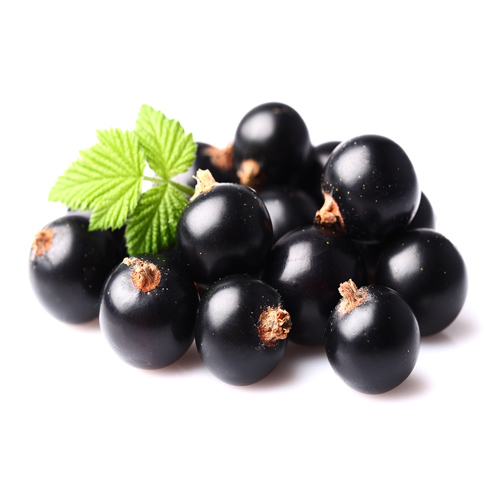
Château Lafite Rothschild – A legend among Cabernet Sauvignons
The Premier Cru Classé from Château Lafite Rothschild is the most prestigious Cabernet Sauvignon in the world. As is usual in Bordeaux, it is a cuvée and not a single varietal Cabernet. The composition of the different base wines varies from vintage to vintage. While Merlot usually accounts for between 5 to 20 percent, Cabernet Sauvignon makes up the lion’s share of the wine at 80 to 95 percent. The proportion of Cabernet Franc and Petit Verdot is negligible at 0.5 to 5 percent each. Anyone who wants to try such a drop should already have the credit card ready. Even in avoidably bad vintages, a true Premier Cru Classé from the house of Château Lafite Rothschild cannot be had for a lower four-digit amount.
What food goes with Cabernet Sauvignon
Cabernet Sauvignon represents a powerful and expressive wine that overwhelms light and delicate dishes. Its high tannin content, the effects of aging in wood and a high alcohol content, typical of some regions, contribute significantly to the wine’s pairing with various dishes. All of these characteristics are most pronounced in young Cabernet Sauvignon, but as it matures, its flavors refine and open up new possibilities for pairing with food.
As a rule, the weight of the wine (alcohol content and body) should be matched to the heaviness of the food. Thus, a Cabernet Sauvignon with a high alcohol content does not pair well with spicy dishes because the alcohol intensifies the spiciness of the capsaicins in the spices, such as chili peppers, and the spiciness in turn intensifies the bitterness of the tannins. In contrast, mild spices such as black pepper are a much better choice, as they do not enhance the effect of the tannins. Two classic combinations are therefore Cabernet Sauvignon with pepper steak or peppered tuna.
Proteins and fats reduce the perception of tannins. When Cabernet Sauvignon is served with meats or dishes with rich buttery cream sauces, the tannins fade into the background and the wine’s fruity flavors are accentuated. In contrast, starchy foods such as pasta and rice have little effect on the tannins in wine.
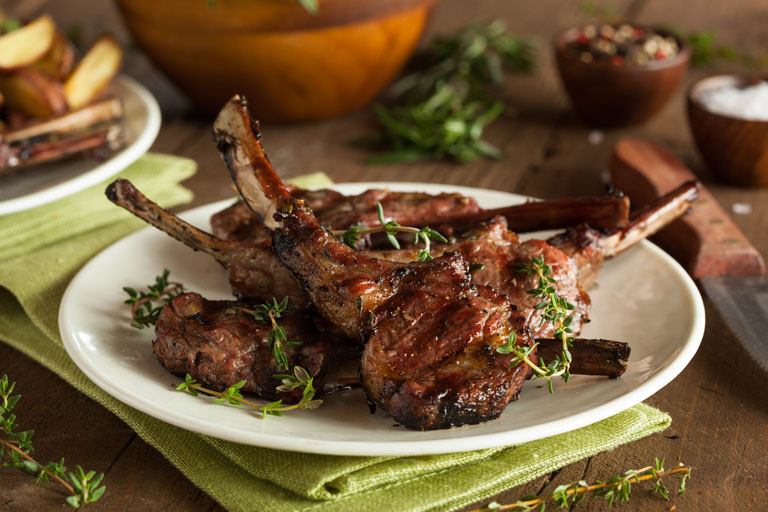
Grilled or slightly bitter ingredients like radicchio and endive, or both, counteract the bitter tannins. Finer and less bitter dishes go well with a mature Cabernet Sauvignon, as it has reduced its high tannin content over time.
Attention barbecue fans! The influence of wood barrel aging harmonizes perfectly with grilled, smoked meats, as these cooking methods bring similar flavors to the food as those in the wine.
The regional differences of Cabernet Sauvignon, of course, also have an effect on the matching dishes. For example, Old World wines, such as those from Bordeaux, typically have more earthy flavors and pair well with dishes that include mushrooms. Wines from cooler climate regions with pronounced vegetal notes go particularly well with vegetarian dishes made from vegetables and leafy greens.
Rich and complex dishes with a variety of flavors are a perfect match for New World Cabernets, due to their bold fruit flavors that are occasionally even perceived as sweet. Dark chocolate and Cabernet Sauvignon also get along quite well, but milk chocolate and other sweet varieties do not.
In general, the wine goes well with various cheeses such as cheddar, mozzarella and brie. Strong cheeses, however, tend to overpower the flavor of Cabernet Sauvignon.
Conclusion
The red wine grape variety Cabernet Sauvignon is not considered the “king of red wines” for nothing. Its excellent storability, multi-faceted styles and suitability as a cuvee partner are just three of its many attributes that have made it the world’s most popular red wine variety over the years.
